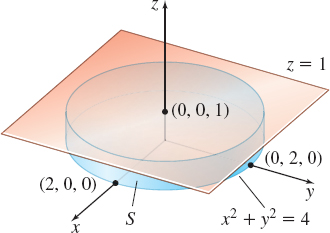EXAMPLE 3Using the Divergence Theorem to Find a Surface Integral
Let S be the surface of a cylindrical solid E whose boundary is x2+y2=4, z=0, and z=1. Let F=x3i+y3j+z2k and let n be the outer unit normal to S. Use the Divergence Theorem to find ∬.
Solution Figure 68 illustrates the cylindrical surface S. We begin by finding {\rm{div}}\mathbf{F}=3x^{2}+3y^{2}+2z. Then we use the Divergence Theorem, obtaining \iint\limits_{S}\mathbf{F}\,{\bf\cdot}\, \mathbf{n}\,dS=\iiint \limits_{E}(3x^{2}+3y^{2}+2z)\,dV
Because E is a cylindrical solid, we use cylindrical coordinates: 3x^{2}+3y^{2}+2z=3r^{2}\cos ^{2}\theta +3r^{2}\sin ^{2}\theta+ 2z=3r^{2}( \cos ^{2}\theta +\sin ^{2}\theta ) +2z=3r^{2}+2z
The solid E is given by 0\leq r\leq 2, 0\leq \theta \leq 2\pi , 0\leq z\leq 1. Then \begin{eqnarray*} \iint\limits_{S}\mathbf{F}\,{\cdot}\, \mathbf{n}\,ds& =&\iiint\limits_E(3x^{2}+3y^{2}+2z)\,dV \underset{\underset{\color{#0066A7}{dV=r\,dr\,d\theta \,dz}}{\color{#0066A7}{\uparrow}}} {=} \iiint\limits_E(3r^{2}+2z)\,r\,dr\,d\theta dz \\ &=&\int_{0}^{2\pi }\int_{0}^{2}\int_{0}^{1}(3r^{3}+2rz)\,dz\,dr\,d\theta \\ & =&\int_{0}^{2\pi }\int_{0}^{2}\big[ 3r^{3}z+r z^{2}\big] _{0}^{1}\,dr\,d\theta =\int_{0}^{2\pi }\int_{0}^{2}(3r^{3}+r)\,dr\,d\theta\\ &=&\int_{0}^{2\pi }\left[ \dfrac{3r^{4}}{4}+\dfrac{r^{2}}{2}\right] _{0}^{2}\,d\theta =\int_{0}^{2\pi }14\,d\theta =28\pi \end{eqnarray*}
